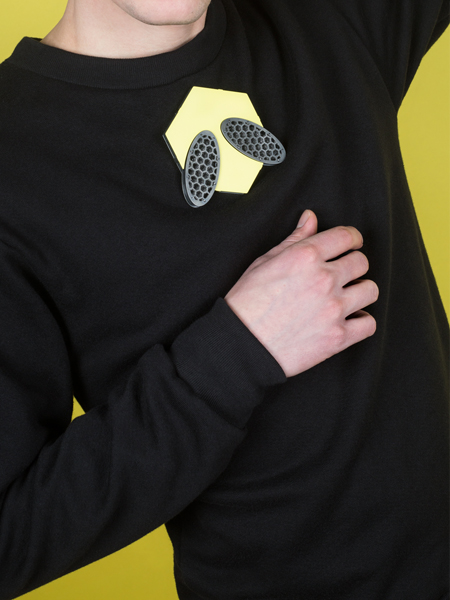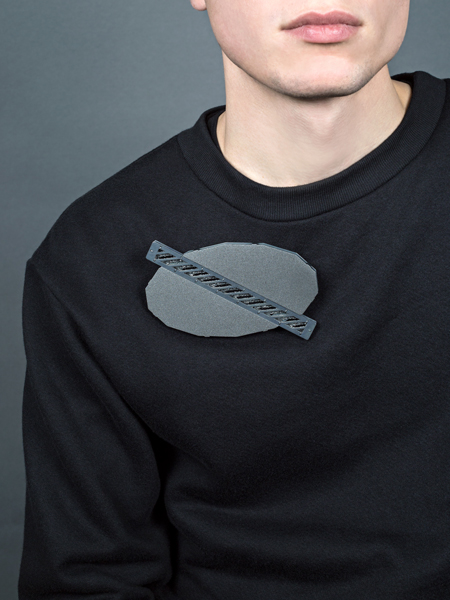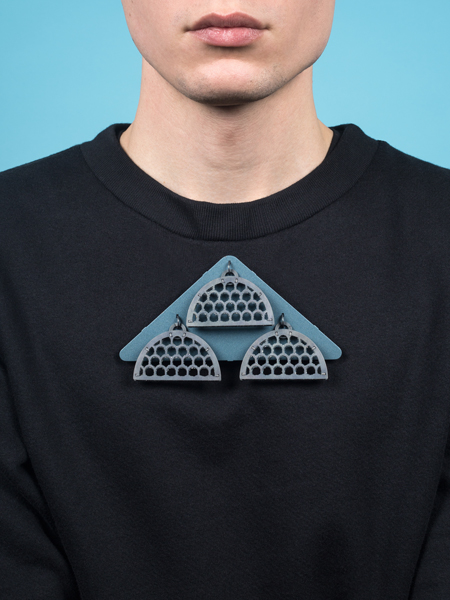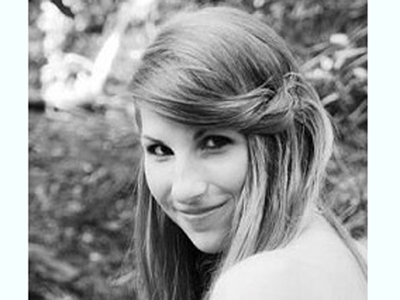
Melanie Isverding’s solo exhibition, In Other Smiles, was recently presented by Gallery Loupe at The Gallery at Reinstein/Ross. In this interview, Melanie discusses the process behind her meticulously crafted forms and how they relate to her questioning of values. She also provides us with a background story about a community tradition she grew up with, and how it is connected to this body of work.
Missy Graff: Please tell me about your journey as an artist. What led you to start making jewelry?
Melanie Isverding: I became interested in jewelry when I was 11 or 12 and my parents brought me to a city for the first time. We went to the Kunstgewerbemuseum in Berlin. Kunstgewerbe means arts and crafts. Yes, that is the place where I saw contemporary jewelry for the first time. I don’t think that my parents were aware of the exhibition. We were just wandering and went there accidentally. I think I was the only one who was interested in the jewelry there.
So, after that, I would think about what I saw at the museum and try to build something similar. I had my first internship as a goldsmith when I was 14 years old, and then I decided to do an apprenticeship right after school when I was 15. That was very fun and I very much enjoyed learning all of the techniques. My apprenticeship was three and a half years long. After I finished my apprenticeship, I worked at the same company for another four years. Everything they did was in the production style. It was a big company, with 200 employees, but it was very much like a family-run business.
When I was 23, I decided that was not the life I wanted anymore. I didn’t want to stay in the village that I grew up in. I decided to get a master’s in craftsmanship at a higher technical school in Hanau, which is close to Frankfurt. That’s where I was introduced to the contemporary jewelry field. I saw all of the Schmuck and Talente catalogs and I became very interested in the pieces. So I applied to study at the Academy of Fine Arts, Munich, where I was a student for five and a half years. I received my diploma in 2012. Since then, I have been working in my studio, and for half of the year I have also been working as an assistant for Daniel Kruger at the Burg Giebichenstein in Halle, so I spend half of the week in Munich and half of the week in Halle.
How has your work changed and developed since graduating from the Academy of Fine Arts in Munich?
Melanie Isverding: At the academy, we were not given any projects. It is all about finding your own approach and your own language. Right before graduation, I discovered a new way of working. Since then, I have developed it to where I am now. I think the body of work has grown a lot. When I first began, I had a very different aesthetic. At first, I wanted the work to be too complex. I wanted to use too many forms in one piece. Now, I have gotten to a point where I have created the right mixture of complexity and clearness, which is quiet at the same time.

Can you describe the concept for the work you are presenting from your Cavea series?
Melanie Isverding: Where do I start? Cavea comes from the Latin word for cage, but it can also refer to a theater stage. It has a sense of protecting and hiding, but it’s also like a stage for showing and exhibiting things. It’s like observing from the inside, but also looking from the outside in. So it has a double meaning.
The cages, or the inside rooms, are filled with crushed stones, minerals, and pearls. I wanted to bring the materials back to their roots: They were connected to stones, they came from the mountains and from deep down in the earth. So, I bring them back to the substances they came from, in a way.
I take the stones and crush them. I pulverize them. They don’t only represent the material they would normally be reduced to. It’s more like a metaphor where they stand for something else, such as personal values. You put certain things into the cage to protect them.
How did you come up with In Other Smiles, the title for this exhibition?
Melanie Isverding: I think it is very much connected to this question of value. Otto Künzli wrote me this poem, where he references Salvador Dali, about my pieces being placative, somehow loud and shiny—raising the idea of the perfect fake and commercialized world. So, the smile refers to the facade and the idea is about looking beyond the facade and asking, “what’s the real substance of the piece?” The stones are about value being hidden and looking at the actual content of the work.
No Porn At Tiffany‘s
Poets of the ages, of all lands, write of ruby lips and teeth of pearls1
And so do I
Lips as bumper bars
Teeth like ploughs
And the spittle flows
It’s gonna be a good good night
Rubybotox
Pearlsilicone
Upholstered vulgar glamour, cheap allurement, please betray me, sexy hell
I kiss you
Fascinated, disgusted, repulsed
Please don’t burst
I was holding you in my hands
Holy brooch “made” by Salvador Dali
Ruby lips
Pearl teeth
The sexiest brooch in The City
Allegory for the full fat life
Landed on my palm on the day after
Not love but death was in the air
Yesterday a snowflake touched-down on my nose
It could have, accidentally, also flown into my mouth
Or cut into my eye
A sharp edged shuriken
Presumably it has melted down by now
Don’t be naive, it was a weapon
It took hundreds of years to figure out the perfect cut for a diamond
Mikimoto spent a lifetime to culture pearls
For Melanie it takes a hammer and a second to smash a pearl and a gemstone2
What she gets, is what it is
The roots
The core
The fragrance
The pigment
The soul
The matter
No smile
Halleluja to the pepper mill
Hurrah to the mortar
Welcome my dear grinders and shredders from all over the world
So far so good
In general
In particular, this text is about an exhibition
In other smiles
Concrete, abstract, yet full of references
Controlled but emotional
Constructed, folded, reversed, turned around
Quiet glow from within, silent preciousness
A light, hidden but accessible
An offer to enter a new realm
It is not so hard to look behind that curtain, to try something new
And often the new turns out to be something we already knew for so long
Something we had lost
I believe that wearing jewellery has nothing to do with shine, with surface, with pretending
It has nothing to do with being sophisticated, smart, educated, special, extraordinary
It has, truly, to do with being
With being true
You should not (and can not) wear jewellery without looking inside of your self (at least a little bit)
Please also look (a little bit) inside of Melanie Isverding’s jewellery before you wear it
The most magical things on earth are often those things, one, at first sight, overlooks
Otto Künzli
1 Quote from Dali – A Study of his Art-in-Jewels. The Owen Cheatham Foundation, New York, 1959
2 I have the feeling Marilyn Monroe is looking over my shoulder while I am writing about a girls best friends
For the actual design of the cages, are you inspired by architecture?
Melanie Isverding: I think most of the shapes come from my history and my childhood. Lots of the shapes and forms are connected to fences, windows, or different kinds of nets that I remember. Some of the necklaces come from a tradition that I know from my childhood. There was a celebration every year called Schützenfest, which is like a ritual. There would always be a king and a queen named from a certain community and then a parade or procession. There is a necklace and every year another charm or badge is connected to it. For years and years this goes on and the necklace grows. All of the badges and shields lie on each other and in each other and it becomes a huge necklace with all of the different shields finding their own place. The necklace belongs to the community and every year it is presented to the new king and queen. I’ve always loved these necklaces because they are full of stories, names, and history. There are lots of stories related to each charm.
The king and queen feel proud wearing the necklace and being seen as someone special for the year. This leads me to question the notion of status. How significant is it to be seen as someone who is important or not? This is an example of the questioning of value and status symbols. Minerals and gemstones can also be symbols of status.

The pieces in this exhibition are all brooches or necklaces. What appeals to you about these formats in the context of your work?
Melanie Isverding: I very much like to make brooches because they are more like objects or stand-alone pieces. I enjoy seeing them on the body, but I also appreciate when the object is strong enough that it is able to stand on its own. Brooches are more autonomous and can also live without the body.
I also like the idea of the necklace, especially in the context of the story I mentioned.
So, do you think of the brooches in relation to the tradition you mentioned earlier?
Melanie Isverding: Yes, I think that it is all connected to that story. My brooches have lots of elements that move. They are connected with rings or bound into the pieces with ribbons. Sometimes the elements find their place and sometimes they are still moving and falling into place when the pieces are worn.
Your pieces are very precise. Do you make models first? How do the techniques you use influence your work? Please tell me about your process.
Melanie Isverding: I start with my imagination. I have a picture in my mind and I develop that idea. I don’t really draw a lot. I don’t carry paper and pencil with me all the time. So, after I form an idea, I begin with paper and scissors to make models from my imagination. I am more or less always cutting out two-dimensional forms to make three-dimensional models. Then I begin drawing on the computer to figure out how many pieces need to be made for the assembly. I do the two-dimensional drawings on the computer. Then I get the metal laser cut. I finish the surfaces by hand before assembling the work; otherwise, the pieces would not fit nicely into each other. It is also very important to me to treat the work by hand so that it does not have the obvious aesthetic of just being laser cut.
I do the inside surface by crushing and grinding the stones. I build up layer after layer with the powder and a special resin until it forms a type of a crust. Those elements are all cold connected by little tabs. I also work with a furniture painter to create the colors that are on the surfaces.
Could you please tell me more about the photographs that you displayed with the work in the exhibition?
Melanie Isverding: This was a recent project I did with a photographer. It was very nice. I have always wanted to do a project like this. I did not want to display too much information about the wearer, so I chose someone who is more androgynous. I chose not to show too much of the face. I wanted to do more work with surfaces and the colors in the background, so the piece becomes the protagonist of the whole portrait in different kinds of positions. I also like that the pieces are not made specifically for male or female. Once they get into a conversation with the body, they do their own job.
Many of our readers are emerging artists. Do you have any advice for jewelers who are just entering the field?
Melanie Isverding: Keep on going! Since I have been a goldsmith for 20 years, I just can’t imagine doing anything else. I think you just have to live it instead of trying to be something or be someone. For me, there’s just so much passion that I don’t question it anymore. It has just become the main part of my life. The process of making work and letting it go into the world is something that gives me so much satisfaction that I just need to do it.





